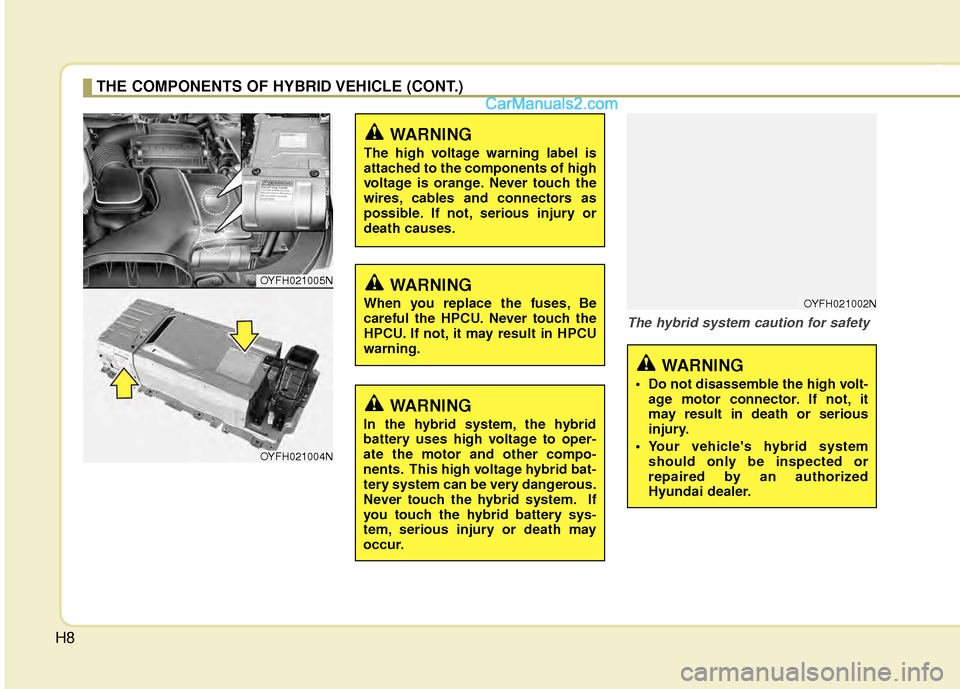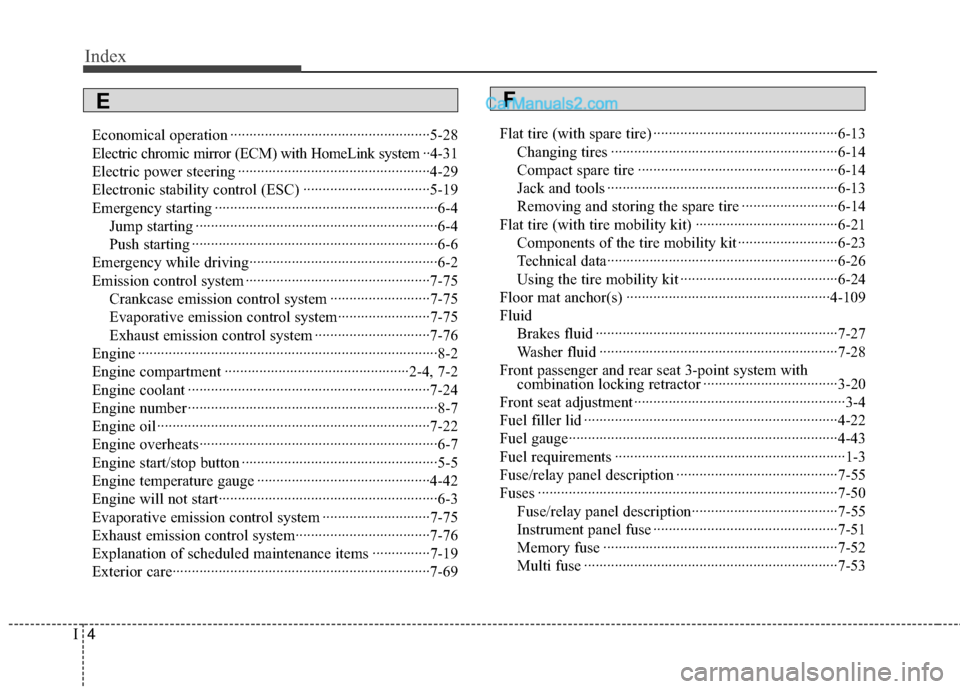2012 Hyundai Sonata Hybrid fuses
[x] Cancel search: fusesPage 189 of 403

Features of your vehicle
108
4
Power outlet
The power outlet is designed to provide
power for mobile telephones or other
devices designed to operate with vehicle
electrical systems. The devices should
draw less than 10 amps with the engine
running.
Digital clock (if equipped)
Whenever the battery terminals or relat-
ed fuses are disconnected, you must
reset the time.
When the engine start/stop button is in
the ACC or ON position, the clock but-
tons operate as follows:
CAUTION
Use the power outlet only when
the engine is running and removethe accessory plug after use.Using the accessory plug for pro-longed periods of time with the engine off could cause the bat-tery to discharge.
Only use 12V electric accessories which are less than 10A in elec-tric capacity.
Adjust the air-conditioner or heater to the lowest operatinglevel when using the power outlet.
Close the cover when not in use. Some electronic devices can cause electronic interference whenplugged into a vehicle’s power out-let. These devices may causeexcessive audio static and malfunc-tions in other electronic systems ordevices used in your vehicle.
WARNING
Do not put a finger or a foreign ele-
ment (pin, etc.) into a power outlet
and do not touch with a wet hand.
You may get an electric shock.
OYF049146NOYF049224
WARNING
Do not adjust the clock while driv-
ing. You may lose your steering
control and cause an accident that
results in severe personal injury or
death.
Page 294 of 403

7
Engine compartment / 7-2
Maintenance services / 7-3
Owner maintenance / 7-5
Scheduled maintenance service / 7-7
Explanation of scheduled maintenance items / 7-19
Engine oil / 7-22
Inverter coolant / 7-24
Engine coolant / 7-24
Brake fluid / 7-27
Washer fluid / 7-28
Parking brake / 7-28
Air cleaner / 7-29
Climate control air filter / 7-30
Wiper blades / 7-32
Battery / 7-34
Tires and wheels / 7-37
Fuses / 7-50
Light bulbs / 7-60
Appearance care / 7-69
Emission control system / 7-75
California perchlorate notice / 7-78
Maintenance
Page 343 of 403

Maintenance
50
7
FUSES
A vehicle’s electrical system is protected
from electrical overload damage by
fuses. This vehicle has 2 fuse panels, one locat-
ed in the driver’s side panel bolster, the
other in the engine compartment.
If any of your vehicle’s lights, acces-
sories, or controls do not work, check the
appropriate circuit fuse. If a fuse has
blown, the element inside the fuse will be
melted.
If the electrical system does not work,
first check the driver’s side fuse panel.
Always replace a blown fuse with one of
the same rating.
If the replacement fuse blows, this indi-
cates an electrical problem. Avoid using
the system involved and immediately
consult an authorized HYUNDAI dealer.
Three kinds of fuses are used: blade type
for lower amperage rating, cartridge type,and multi fuse for higher amperage rat- ings.
OBK079042
Normal
Normal
Blade type
Cartridge type
Multi fuse Blown
Blown
Normal Blown
WARNING - Fuse replace-
ment
Never replace a fuse with any-
thing but another fuse of the
same rating.
A higher capacity fuse could cause damage and possibly a
fire.
Never install a wire or aluminum foil instead of the proper fuse -
even as a temporary repair. It may
cause extensive wiring damage
and a possible fire.
CAUTION
Do not use a screwdriver or anyother metal object to remove fuses because it may cause a short circuitand damage the system.
Page 344 of 403

751
Maintenance
Instrument panel fuse replace-
ment
1. Turn the engine start/stop button andall other switches off.
2. Open the fuse panel cover. 3. Pull the suspected fuse straight out.
Use the removal tool provided in the
engine compartment fuse panel.
4. Check the removed fuse; replace it if it is blown.
5. Push in a new fuse of the same rating, and make sure it fits tightly in the clips.
If it fits loosely, consult an authorized
HYUNDAI dealer.
If you do not have a spare, use a fuse of the same rating from a circuit you maynot need for operating the vehicle, suchas the cigarette lighter fuse.
If the headlights or other electrical com-
ponents do not work and the fuses are
OK, check the fuse panel in the engine
compartment. If a fuse is blown, it must
be replaced.
Memory fuse
Your vehicle is equipped with a memory
fuse to prevent battery discharge if your
vehicle is parked without being operated
for prolonged periods. Use the following
procedures before parking the vehicle for
prolonged periods.
1. Turn off the engine.
2. Turn off the headlights and tail lights.
3. Open the driver’s side panel cover and pull up the memory fuse.
OYF079020OYFH071021NOYF079022
Page 352 of 403

759
Maintenance
Engine compartment sub fuse panel (Sub-relay box) Engine compartment main fuse panel (Engien junction fuses)
DescriptionFuse rating Protected component
OPCU 80AOPCU Relay
C/FAN 60AC/FAN HI Relay
Relay No. Relay Name Type
E41 ACC Relay PLUG MICRO
E42 RR HTD Relay PLUG MICRO
E43 - PLUG MICRO
E44 C/FAN LO Relay PLUG MICRO
E45 AUX Water Pump Relay PLUG MICRO
E46 - PLUG MICRO
E47 Deicer Relay PLUG MICRO
E48 - PLUG MICRO
E49 IG1 Relay PLUG MICRO
E50 IG2 Relay PLUG MICRO
E51 Wiper Relay PLUG MICRO
E52 T/Turn Door Unlock Relay PLUG MICRO
E53 HAC Realy PLUG MICRO
E54 Blower Relay PLUG MICRO
EMS BOX RLY.1 Horn Relay
PLUG MICRO
RLY.2 F/Pump Relay PLUG MICRO
RLY.3 ECU Relay PLUG MINI
Page 389 of 403

H8
The hybrid system caution for safety
THE COMPONENTS OF HYBRID VEHICLE (CONT.)
WARNING
In the hybrid system, the hybrid
battery uses high voltage to oper-
ate the motor and other compo-
nents. This high voltage hybrid bat-
tery system can be very dangerous.
Never touch the hybrid system. If
you touch the hybrid battery sys-
tem, serious injury or death may
occur.
WARNING
The high voltage warning label is
attached to the components of high
voltage is orange. Never touch the
wires, cables and connectors as
possible. If not, serious injury or
death causes.
WARNING
When you replace the fuses, Be
careful the HPCU. Never touch the
HPCU. If not, it may result in HPCU
warning.
OYFH021005N
OYFH021004N
OYFH021002N
WARNING
• Do not disassemble the high volt-age motor connector. If not, it
may result in death or serious
injury.
Your vehicle's hybrid system should only be inspected or
repaired by an authorized
Hyundai dealer.
Page 391 of 403

H10
Service plug
This service plug (1) located in the rear
trunk as shown should always be pulled
out to disconnect and turn off the hybrid
system.
IMPORTANT: Wait 5 minutes after this
lever is disconnected to work on the
car to assure all remaining charge in
the system has dissipated.
THE COMPONENTS OF HYBRID VEHICLE (CONT.)
WARNING
This hybrid vehicle uses the hybrid
battery system inverter and con-
verter to generate high voltage.
High voltage in the hybrid battery
system is very dangerous and can
cause severe burns and electric
shock. This may result in serious
injury or death.
For your safety, never touch,replace, dismantle or remove the
hybrid battery system including
components, cables and connec-
tors. Severe burns or electric
shock may result in serious
injury or death if you do not fol-
low this warning.
When the hybrid battery system operates, the hybrid battery sys-
tem can be hot. Always be care-
ful because burns or electric
shock maybe caused by high
voltage.
Do not drop water or liquid to HPCU, HSG, Motor and fuses. The
hybrid system components are
covered, If you drop water or liq-
uid to hybrid system components,
it may result in electronic shock.
WARNING
This plug is attached to the hybrid
battery system, which contains
very dangerous high voltage.
Touching the service lever may
cause severe burns or electric
shock. When you touch it, be care-
ful not to damage.
OYFH061020N
Page 398 of 403

Index
4I
Economical operation ··················\
··················\
················5-28
Electric chromic mirror (ECM) with HomeLink system ··4-31
Electric power steering ··················\
··················\
··············4-29
Electronic stability control (ESC) ··················\
···············5-19
Emergency starting ··················\
··················\
··················\
····6-4 Jump starting ··················\
··················\
··················\
·········6-4
Push starting ··················\
··················\
··················\
··········6-6
Emergency while driving··················\
··················\
·············6-2
Emission control system ··················\
··················\
············7-75 Crankcase emission control system ··················\
········7-75
Evaporative emission control system··················\
······7-75
Exhaust emission control system ··················\
············7-76
Engine ··················\
··················\
··················\
··················\
······8-2
Engine compartment ··················\
··················\
············2-4, 7-2
Engine coolant ··················\
··················\
··················\
·········7-24
Engine number ··················\
··················\
··················\
···········8-7
Engine oil ··················\
··················\
··················\
·················7-22\
Engine overheats··················\
··················\
··················\
········6-7
Engine start/stop button ··················\
··················\
···············5-5
Engine temperature gauge ··················\
··················\
·········4-42
Engine will not start··················\
··················\
··················\
···6-3
Evaporative emission control system ··················\
··········7-75
Exhaust emission control system··················\
·················7-76\
Explanation of scheduled maintenance items ···············7-19
Exterior care··················\
··················\
··················\
·············7-69 Flat tire (with spare tire) ··················\
··················\
············6-13
Changing tires ··················\
··················\
··················\
·····6-14
Compact spare tire ··················\
··················\
················6-14
Jack and tools ··················\
··················\
··················\
······6-13
Removing and storing the spare tire ··················\
·······6-14
Flat tire (with tire mobility kit) ··················\
··················\
·6-21 Components of the tire mobility kit ··················\
········6-23
Technical data··················\
··················\
··················\
······6-26
Using the tire mobility kit ··················\
··················\
·····6-24
Floor mat anchor(s) ··················\
··················\
·················4-10\
9
Fluid Brakes fluid ··················\
··················\
··················\
·········7-27
Washer fluid ··················\
··················\
··················\
········7-28
Front passenger and rear seat 3-point system with combination locking retractor ··················\
·················3-20\
Front seat adjustment ··················\
··················\
··················\
·3-4
Fuel filler lid ··················\
··················\
··················\
············4-22
Fuel gauge··················\
··················\
··················\
················4-43
Fuel requirements ··················\
··················\
··················\
······1-3
Fuse/relay panel description ··················\
··················\
······7-55
Fuses ··················\
··················\
··················\
··················\
······7-50 Fuse/relay panel description··················\
··················\
··7-55
Instrument panel fuse ··················\
··················\
············7-51
Memory fuse ··················\
··················\
··················\
·······7-52
Multi fuse ··················\
··················\
··················\
············7-53
EF